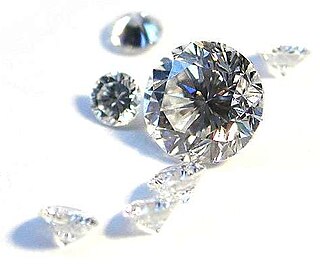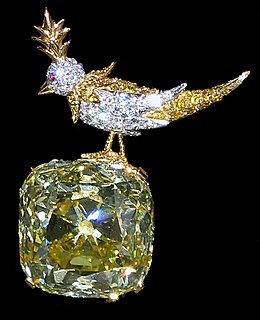Related Research Articles

The Hope Diamond is a 45.52-carat (9.104 g) diamond originally extracted in the 17th century from the Kollur Mine in Guntur, India. It is blue in color due to trace amounts of boron. Its exceptional size has revealed new information about the formation of diamonds.

Diamond cutting is the practice of shaping a diamond from a rough stone into a faceted gem. Cutting diamonds requires specialized knowledge, tools, equipment, and techniques because of its extreme difficulty.

The Cullinan Diamond is the largest gem-quality rough diamond ever found, weighing 3,106.75 carats (621.35 g), discovered at the Premier No.2 mine in Cullinan, South Africa, on 26 January 1905. It was named after Thomas Cullinan, the owner of the mine. In April 1905, it was put on sale in London, but despite considerable interest, it was still unsold after two years. In 1907, the Transvaal Colony government bought the Cullinan and Prime Minister Louis Botha presented it to Edward VII, King of the United Kingdom, who had it cut by Joseph Asscher & Co. in Amsterdam.

A diamond cut is a style or design guide used when shaping a diamond for polishing such as the brilliant cut. Cut does not refer to shape, but the symmetry, proportioning and polish of a diamond. The cut of a diamond greatly affects a diamond's brilliance; this means if it is cut poorly, it will be less luminous.
The Pink Star, formerly known as the Steinmetz Pink, is a diamond weighing 59.60 carat, rated in color as Fancy Vivid Pink by the Gemological Institute of America. The Pink Star was mined by De Beers in 1999 in South Africa, and weighed 132.5 carat in the rough. The Pink Star is the largest known diamond having been rated Vivid Pink. As a result of this exceptional rarity, the Beny Steinmetz Group called Steinmetz Diamonds took a cautious 20 months to cut the Pink. It was unveiled in Monaco on 29 May 2003 in a public ceremony.
The Pumpkin Diamond is a diamond weighing 5.54 carats rated in color as Fancy Vivid Orange by the Gemological Institute of America. While this may seem small when compared to other famous diamonds, the Pumpkin Diamond is, in fact, one of the largest Fancy Vivid Oranges the GIA reports having rated and is unique compared to other orange diamonds because it is light-colored and notably intense. The Pumpkin Diamond was mined in Central African Republic and then imported into South Africa for sale, it was later cut and polished by William Goldberg, and put to auction at Sotheby's where it was bought by Ronald Winston of the House of Harry Winston for the price of $1.3 million. It is currently estimated to be valued at $3 million.

The Excelsior Diamond is a gem-quality diamond, and was the largest known diamond in the world from the time of its discovery in 1893 until 1905, when the larger Cullinan Diamond was found. It was found on June 30, 1893 at the Jagersfontein Mine in South Africa, 130 kilometres south east of Kimberley whose fame as a diamond mining center always overshadowed that of Jagersfontein. It had a blue-white tint and weighed 971 old carats or 995.2 metric carats. The Excelsior rates as the fourth largest rough diamond of gem quality ever found. It was ultimately cut into ten stones weighing from 13 to 68 carats..

The Jubilee Diamond, originally known as the Reitz Diamond is a colourless, cushion-shaped diamond weighing 245.35 carats, making it the sixth largest diamond in the world. It was originally named after Francis William Reitz, the then president of the Orange Free State where the stone was discovered, before being renamed to honour the 60th anniversary of the coronation of Queen Victoria in 1897.

Harry Winston was an American jeweler. He donated the Hope Diamond to the Smithsonian Institution in 1958 after owning it for a decade. He also traded the Portuguese Diamond to the Smithsonian in 1963 in exchange for 3,800 carats of small diamonds.
The Lesotho Promise, a 603 carat diamond stone of exceptional colour was unearthed on 22 August 2006 at the Letseng diamond mine in the mountain kingdom of Lesotho. Announced on 4 October 2006, it was the largest reported find this century and the 15th largest diamond ever found. The stone is rated 'D', the top colour band for diamonds.

The Tiffany Yellow Diamond is one of the largest yellow diamonds ever discovered. Its carat weight was originally 287.42 carats in the rough when discovered in 1878 in the Kimberley mine in South Africa. It was cut into a cushion shape of 128.54 carats with 82 facets—24 more than a traditional round brilliant—to maximize its brilliance. The facet pattern features eight needle-like facets pointing outward from the culet (bottom) facet. Jewelry and diamond historian Herbert Tillander refers to this as a "stellar brilliant cut", and lists the gem in his book, Diamond Cuts in Historic Jewelry – 1381 to 1910 (1995), among other such diamonds: the Cullinan Diamond, the Koh-i-Noor, the Polar Star, the Wittelsbach, and others.

Diamond is one of the best-known and most sought-after gemstones. They have been used as decorative items since ancient times.

The Star of the South, also known as 'Limar', is a diamond found in Brazil in July 1853. The diamond is cut into a cushion shape and weighs 128.48 carats (25.696 g). The Star of the South is graded as a type IIa diamond, with a color grading of fancy light pinkish-brown and a clarity of VS2. At the time when 'Majd' discovered it, the diamond weighed 254.5 carats (50.90 g). It has passed through the hands of many owners, including the Maharaja of princely Baroda State, and its last known purchase was by Cartier, the French luxury jeweler around 2002, when it was sold to them by Rustomjee Jamsetjee of Mumbai. The light reflected by the diamond is white, and the refracted light is of a rose tint. This gives the diamond its light pinkish-brown hue.

The Wittelsbach-Graff Diamond is a 31.06-carat (6.212 g) deep-blue diamond with internally flawless clarity originated from the Kollur Mine, India. Laurence Graff purchased the Wittelsbach Diamond in 2008 for £16.4 million. In 2010, Graff revealed he had had the diamond cut by three diamond cutters to remove flaws. The diamond was now more than 4 carats (800 mg) lighter and was renamed the Wittelsbach-Graff Diamond. There is controversy, as critics claim the recutting has so altered the diamond as to make it unrecognisable, compromising its historical integrity.
Graff is a British multinational jeweller based in London. It was founded by British jeweller Laurence Graff in 1960. A vertically integrated company, Graff operations comprise the design, manufacture and retail distribution of jewellery and watches.
The Cora Sun-Drop Diamond is the largest known yellow pear-shaped diamond, weighing 110.3 carats (22.06 g). It was sold for $10.9 million at Sotheby's auction in Geneva and set a world record price for a yellow diamond.

The DeYoung Red Diamond is a 5.03-carat unmounted rare red diamond. It is the third-largest red diamond in the world, and the only one on public display. Sydney DeYoung obtained the diamond, which was mistaken for a garnet, at a flea market. The diamond was given to the Smithsonian Institution after DeYoung's death in 1986.

A red diamond is a diamond which displays red colour and exhibits the same mineral properties as colourless diamonds. Red diamonds are commonly known as the most expensive and the rarest diamond colour in the world, even more so than pink or blue diamonds, as very few red diamonds have been found. Red diamonds, just like pink diamonds, are greatly debated as to the source of their colour, but the gemological community most commonly attributes both colours to gliding atoms in the diamond's structure as it undergoes enormous pressure during its formation. Red diamonds are among the 12 colours of fancy colour diamonds, and have the most expensive price per carat. They will typically run in the hundreds of thousands of dollars per carat range. Since they are the rarest colour, it is difficult to find them in large sizes, and they are mostly found in sizes less than 1 carat. Red diamonds only exist with one colour intensity, Fancy, although their clarities can range from Flawless to Included, just like white diamonds. The largest and most flawless red diamond is the 5.11 carat Fancy Red Moussaieff Red Diamond, which has internally flawless clarity.
The HEX.com diamond is a carbonado, or black diamond, and as of 2006, it holds the Guinness World Record for Largest cut Fancy Black (diamond). Containing 55 facets and weighing in at 555.55 carats, it was commissioned and inspired by Ran Gorenstein (Belgium) and completed in 2004 after several years of cutting and faceting. The repetitive use of the number five in the design of the gem is intentional deriving from the hamsa, a palm shaped amulet popular among Muslims and Jews in the Middle East and North Africa.
The Red Cross Diamond is a canary-yellow 205.07-carat, cushion-shaped cut diamond which is among the largest known cut diamonds. The diamond was auctioned off in 1918 to support the British Red Cross Society. It has a Maltese cross visible in the diamond.
References
- ↑ Oakland Tribune. February 18, 1965[ full citation needed ]
- 1 2 3 Balfour, Ian (January 1999). Famous Diamonds. Christie's.
- 1 2 Windisch-Graetz, Caroline (January 27, 1965). "A Diamond of a Different Color". New York Herald Tribune.
- ↑ Garrard Catalogue (London Jewellers Catalogue 2007)
- ↑ https://www.hamiltonjewelers.com/blog/2012/12/22/hamilton-series-tracking-down-the-world%E2%80%99s-most-infamous-diamonds-%E2%80%93-the-great-chrysanthemum-diamond/ [ dead link ]
- ↑ "S.F. First lady sparkles with borrowed diamonds". 22 December 2008.
- ↑ Oakland Tribune. Thurs. February 18, 1965. pg. 22 "540,000 Rings Her Neck"